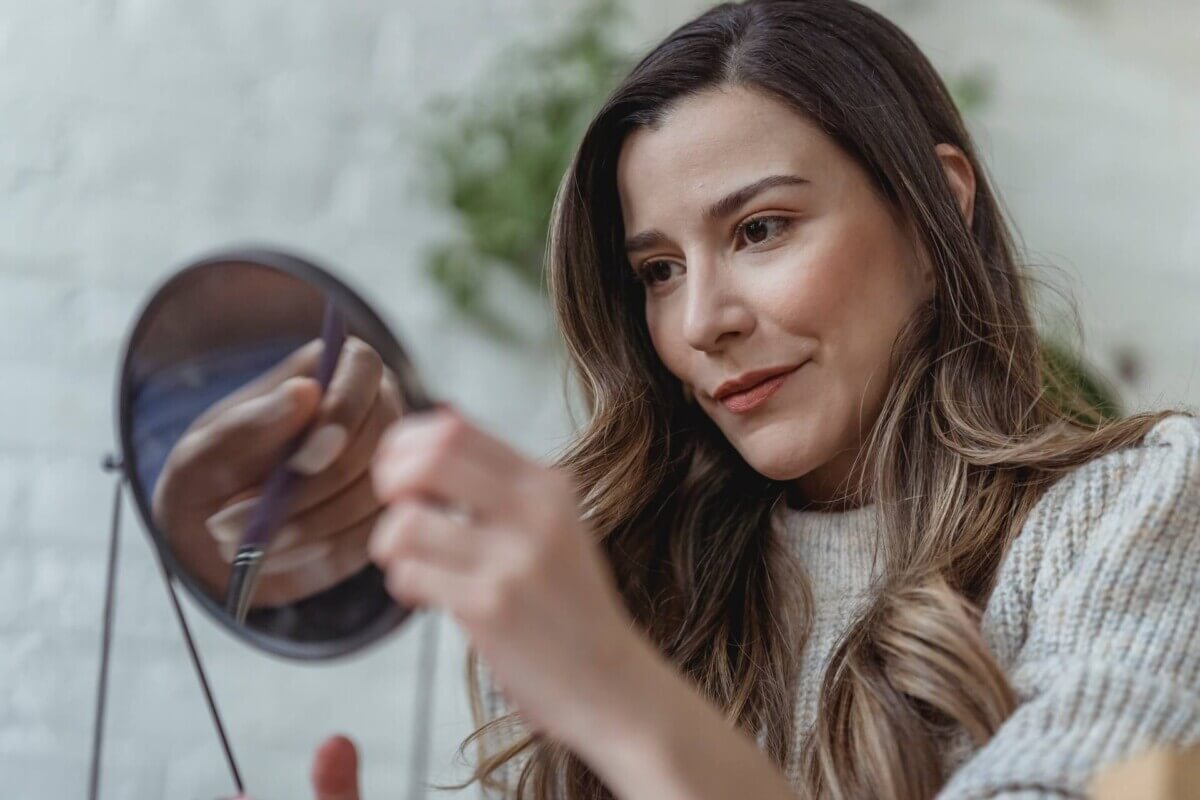
Woman looking the mirror (Credit: George Milton from Pexels)
Skin changes as we age. Proteins called collagen and elastin keep skin firm and elastic. Over time, these start to break down, resulting in sagging and wrinkles. Your skin produces less oil and becomes thinner and more delicate, especially around the eyes.
Skin turnover slows down. That’s why there’s so much caution about the Sun, as your lifetime exposure can cause uneven pigmentation and age spots. However, you can slow the aging process by avoiding sun exposure, not smoking, and maintaining a good skincare routine.
Here are 5 tips for taking care of aging skin:
- Cleanse gently once daily with a mild cleanser.
- Moisturize often, after a shower, and as often as your skin feels dry.
- Use sunscreen every morning, with an SPF of at least 30.
- Add antioxidants. Products with vitamin C can protect the skin from environmental damage caused by free radicals. They also brighten the skin, even skin tone, and can even inhibit excess pigmentation.
- Exfoliate gently once or twice weekly to remove dead skin cells. Using topical products is better than physical exfoliation (such as a washcloth). Retinoids and alpha and beta hydroxy acids are chemical exfoliants. Follow the directions. Too much or too often irritates the skin.
What about wrinkles?
These lines and creases form especially on the forehead and around the eyes and mouth, as skin loses its elasticity, aggravated by sun exposure and gravity. Retinoids are one of your most effective treatment methods.
Retinoids are vitamin A-based skin care products. They boost collagen, thicken the skin, and smooth the outer layer. Some are available by prescription, such as tretinoin (Retin-A) and tazarotene (Avage). Topical retinol or retinal is widely available in over-the-counter products.
There are some more invasive treatment options available from dermatologists, other physicians, and some estheticians. Check the licensing of the clinicians.
Here are 3 invasive treatment options for wrinkles:
- Neuromodulators: Botulinum toxin (Botox) temporarily relaxes some facial muscles to smooth wrinkles and lines. They block nerve signals to the muscles, reducing wrinkles caused by facial expressions for three to six months.
- Microneedling: Tiny needles are used to create small injuries in the skin. It stimulates collagen production to smooth the skin.
- Soft tissue fillers: Substances such as hyaluronic acid jells are injected into the face to restore fullness and smooth wrinkles, primarily in the cheeks and lips. Results are immediate and last six months to two years.
What are age spots?
Solar lentigo is the medical name for an age spot. They are also called liver or sunspots. These flat brown, gray, or black spots appear on areas exposed to the Sun, like the face and hands. Young people get them with enough sun exposure, but they are more common in people over 50. Solar lentigos are harmless but, for some people, can be a cosmetic concern. They do not transform into cancer.
Products with hydroquinone, retinoid, or vitamin C can fade spots over time. These creams or lotions may be labeled as “spot correctors” or “brighteners.”
A dermatologist or licensed clinician can also apply a chemical peel, a solution containing alpha-hydroxy acids, trichloroacetic acid, glycolic acid, or lactic acid, to the skin. The peel removes the top layer of the skin, making the spots less apparent.
Laser treatments target pigment cells, fading age spots. They are more intense and may require multiple sessions. They are unsuitable for some skin conditions, pregnancy, and skin prone to scarring.
How to deal with undereye bags
Puffiness or darkening under the eyes is referred to as undereye bags or dark circles. It’s caused by weakened tissues and muscles around the eyes. Genetics, lack of sleep, and fluid retention can make them more noticeable.
Here are some tips to reduce their appearance:
- A cold compress to the area can reduce puffiness temporarily.
- Topical caffeine in the form of a cream or gel can reduce swelling and discoloration.
- Peptides, found in many eye creams, can reduce dark circles. Some stimulate collagen and elastin, others block enzymes that break down skin, and some deliver nutrients that repair and strengthen skin.
- Sleeping on your back, with your head slightly elevated, may reduce fluid buildup around the eyes.
The final word
If you’re looking to improve your skin’s health as you age, the process is simple: cleanse, moisturize, brighten, moisturize, exfoliate, moisturize, avoid sun exposure, moisturize, don’t smoke, and (if it’s not obvious already) moisturize, moisturize, moisturize.







